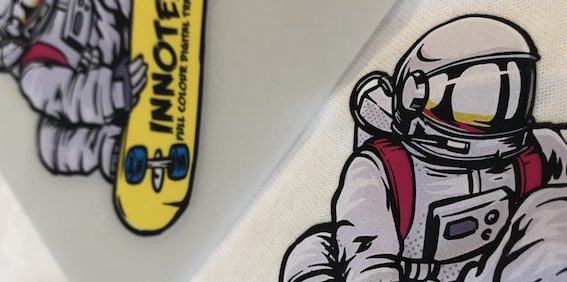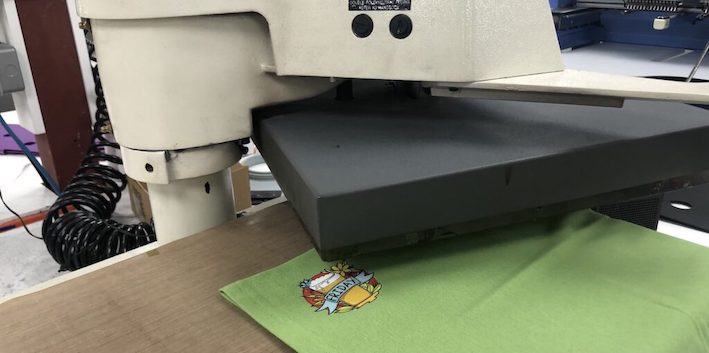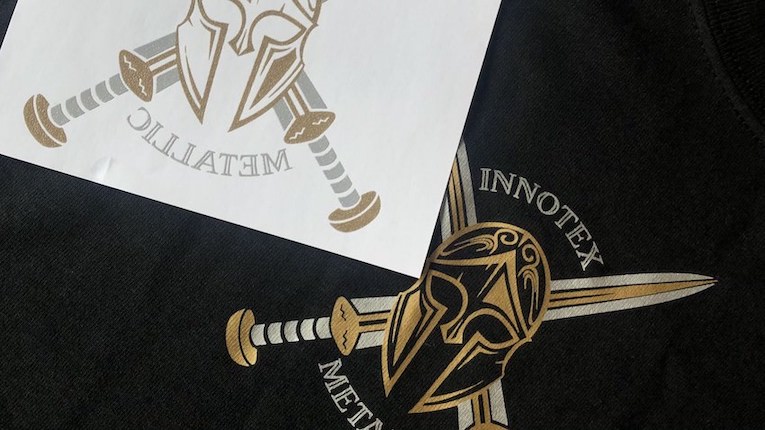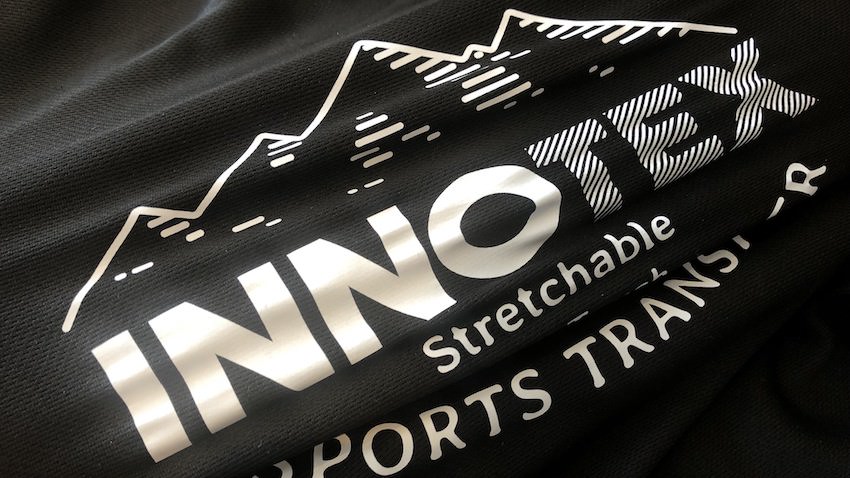Heat transfers for clothing can be a tricky subject if you’re not familiar with the specifics of garments. There are various factors involved surrounding the suitability of a garment for specific transfer types. If you’re unsure on how heat transfers for clothing works, we’ve got a guide for you! We’re covering the do’s and don’ts of garment materials, so stick around. This includes the importance of knowing what to do when working with light and dark fabrics!
What is Heat Transfer Printing?
If you’re new to the industry or you just want to design your own clothes, it’s good to get a grasp on the basics of heat transfer printing. The method requires using a heat source to transfer the print onto your garment and the source is usually a heat press machine. Firstly, place the garment on the platen (the flat surface). Next, press down on the garment for 5-10 seconds. And you’re done – just remove the transfer paper off of the garment! It sounds simple and it can be, but not always. That’s what this guide is here to change! It’s not as basic as finding a google image, then printing it using a standard printer and stamping it on. That’ll give you a really low quality finish and so much can go wrong with your garments because of the wrong equipment.
Heat press machines are easy to handle, but some machines can provide more convenience. This is dependant on your desired use and can be easily identified. The heat transfer process allows for garments to get a good quality finish for a low price, so anyone can do this! Are you producing in high quantity, because if so, you’ll still benefit from this! For the most part, garments are suitable for standard methods; with that said, some materials require either more or less heat. In other circumstances, some fabrics aren’t suitable for heat pressing at all!
Check out our ultimate guide to heat press machines here so you understand the process!

Using the Right Printers for Your Designs
If you’re producing heat transfers for clothing, you can’t just use a standard piece of paper and a printer because transfer paper is made to handle high heat. In addition, this is why standard paper isn’t used for the process. Moreover, it’ll burn because standard printer paper doesn’t contain the coating to transfer the ink between the paper and the garment.
Transfer paper works well with both inkjet and laser printers, so make sure you have one before you work with them. You can use transfer paper in place of printer paper and the print will come out as normal. It’s recommended that your design is vectored because this will allow for the highest quality, compared to png or jpeg. This topic is a whole other conversation, that’ll be covered another time!
Heat Press Requirements for Garment Types
You can use heat press machines for various garment types, such as sportswear, everyday clothing and workwear. As mentioned, some materials are susceptible to scorching if you don’t check the material beforehand. Let’s run through the different garment types for heat transfers.
Stretch
Material such as nylon or lycra needs an increase in heat to transfer the print over effectively. Since the material has the capability of stretching and adapting to different sizes, the fibres work differently to cotton. To ensure the print stays in place, there are also several techniques available for stretchy material, which we’ll get onto later. If you’re going for the standard heat press process, we recommend a temperature of 165-170ºC for about 12-14 seconds.
Cotton
Cotton can be heat pressed at higher temperatures and it is a very common material to heat press on. 165ºC is the recommended setting for your machine. However, you can increase the temperature up to 185ºC depending on the thickness of the garment! Also, you can press for up to 15 seconds with cotton, however 10 seconds is satisfactory. Most casual wear contains a high amount of cotton; if you’re printing on your old clothes at home, this setting will be ideal for you. Be sure to check the labels just in case!
Polyester
Stretch and reflective material are both polyester or have some polyester in them. However, when heat pressing on 100% polyester, you must be wary about temperature. This is because it isn’t made for contact with high temperatures. In other words, your heat press machine will need to be set to a lower temperature. As a result, you’ll need to press for 10 seconds instead of 5 seconds, to allow the transfer to stick. We recommend you press polyester garments at around 135ºC for best results.
Reflective Material
The polyester in reflective material allows for different methods of transfers. Since reflective is a different kind of garment compared to everyday clothing, you can keep your options open. If you’re planning to use the standard method, set your heat press to 150ºC. Add firm pressure for 10-12 seconds to ensure maximum retention to the garment.
The bottom line is, cotton is the only material mentioned above that works best with standard heat press methods. Cotton, polyester and reflective material require additional support during the heat transfer process. This allows for maximum bonding with their fibres. Doing this doesn’t mean to say a typical heat press process won’t produce high quality prints. This just means there’s alternatives to maximise your print quality to ensure durability for the long term.
To make it simpler to grasp the requirements of each material, I’ve set out them out briefly in the table below
Material | Temperature | Time |
Stretch | 165-170ºC | 12-14 seconds |
Cotton | 165-185ºC | 10-15 seconds |
Polyester | 135ºC | 10 seconds |
Reflective | 150ºC | 10-12 seconds |
Choosing the Right Transfer Paper: Light vs Dark Garments
Transfer paper is easy to come by – you can purchase it online or at stationary stores. The difference between transfer paper and printer paper is the coated polymer layer that allows the transfer to take place. If you’re printing on a dark garment as opposed to a light garment, you’ll need light transfer paper. Pastel garments can also be considered light garments.
However, colours such as dark grey, blues, and black require dark garment transfer paper. If you’re using an inkjet printer, white is not going to be visible. Therefore, you’ll need the background of a dark garment to show your print.

Another thing to note is that there’s a slight difference in the heat transfer method between light garments versus dark garments. For one, light garment’s require a print that is a reversed image. This is because you’ll be facing the artwork down on the garment for the transfer to take place. When you reverse the image, it’ll appear facing the correct way as you flip the transfer paper down. Don’t think too hard about it.
With that said, if you’re working with a dark garment, you need to NOT do this with dark garments. You’ll need to print your design the way you want it to be shown to others. In other words, print it WITHOUT reversing the artwork! The next step is to face your transfer paper with the design facing UP, not down on the heat press. The ink will transfer between the polymer onto your garment and appear as you see it just before you press. It’s easier to work with dark garments rather than light, since you can see exactly how your design will look!
Avoiding Errors During Heat Transfer
Sometimes errors can occur during heat transfers for various reasons. This could be down to using the wrong temperature or keeping the garment pressed for too long. Sometimes the ink can bleed, which means the ink has been exposed in the garment and doesn’t remain where it should. In order to avoid errors like this during heat transfers for clothing, you can use a different type of transfer sheet (subliblock transfer paper) to act as a guard against bleeding.
Stretchy and reflective material will print well if you stick between 180-200ºC. There’s more to this than mentioned above, especially when working with sublimation printing as a whole. The difference between sublimation printing and heat transfers isn’t in the method. The difference is within the scientific background of the sublimation process. In short, sublimation printing permanently transfers the ink into the fibres of the garment. That’s why it’s great for the 3 material types mentioned earlier and not so much cotton. Standard heat transfers adhere to the garment.

The actual background knowledge you need to know before you start sublimation printing is quite vast and that’s why we’ve got an in-depth guide with tips for avoiding dye migration.
Now that you’re ready to start your heat transfers for clothing, we’re still here to support your process by providing you with high quality ready-to-press transfers, using state-of-the-art machinery! Call us at 020 3617 8710 to discuss your queries further, or submit your request on our contact us page.
